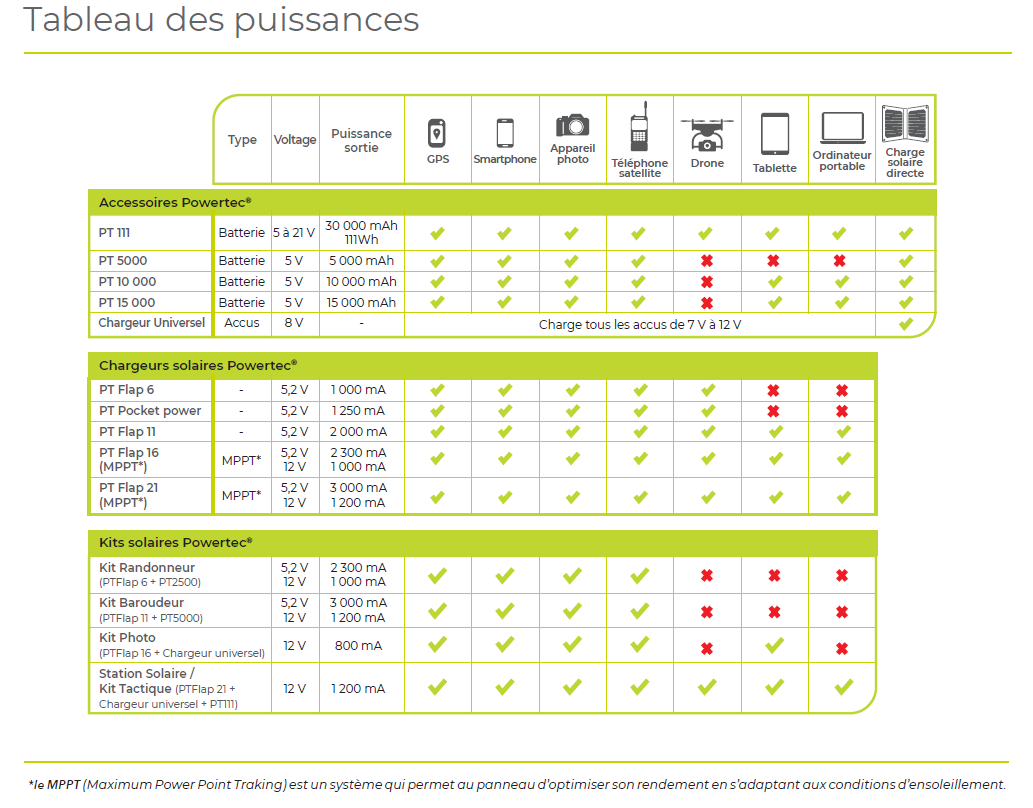Mini Cart
Introduction
In today’s fast-paced, technology-driven world, a solar phone charger is essential. These devices enable you to recharge your electronic devices in an environmentally-friendly and convenient way. In this article, we’ll look at the features you need to consider when choosing the best solar charger for your phone, as well as the advantages and disadvantages of this technology. We’ll also present a comparison of the best models available on the market.
1. Operation and features of a solar charger
How does a solar charger work?
A solar charger uses the sun’s energy to generate electricity. It is equipped with photovoltaic panels that capture sunlight and convert it into electrical energy. This energy is then stored in an internal or power bank, ready to be used to recharge a phone or other electronic device.
Features to consider when buying a solar charger
- Power: The power of a solar charger is expressed in watts (W). The higher the wattage, the faster your phone will recharge. A wattage of 10 to 20 W is generally sufficient to recharge a smartphone.
- Efficiency: Efficiency determines the amount of solar energy converted into electricity. A solar charger with an efficiency of 20% to 25% is considered efficient.
- Compatibility: Check that the solar charger is compatible with your phone and other devices you wish to charge.
- Battery capacity: If the solar charger has a built-in battery, take into account its capacity (expressed in mAh) to determine how many times you can recharge your phone.
2. Advantages of solar chargers
Ecological and economical
One of the main advantages of solar chargers is their ecological aspect. By using solar energy, you reduce your carbon footprint and help preserve the environment. What’s more, solar energy is free and inexhaustible, so you can save on your electricity bills.
Energy independence
A solar charger lets you charge your phone wherever you are, without having to search for an electrical outlet. Particularly useful when traveling, hiking or at outdoor events.
Versatility
Some solar chargers feature multiple USB ports, so you can charge several devices simultaneously. They can also be used to power other electronic devices, such as tablets, cameras or speakers.
3. Disadvantages of solar chargers
Recharge speed
The recharging speed of a solar charger depends on the power of the solar panels and the amount of sunlight. As a result, it can be slower than that of a traditional charger, especially on cloudy days or indoors.
Dimensions
Solar chargers are generally bulkier and heavier than traditional chargers, due to the size of the solar panels. However, there are lightweight foldable models designed for easy transport.
4. Comparison of the best solar phone chargers
- Model A: This solar charger offers 15 W of power and 22% efficiency. It is compatible with most smartphones and has a built-in 10,000 mAh battery. It has two USB ports for recharging several devices simultaneously.
- Model B: This model offers 20 W power and 24% efficiency. It is compatible with many electronic devices and has no built-in battery, making it lighter and less bulky. It also features four eyelets for easy attachment to a backpack or tent.
- Model C: This folding solar charger boasts 10 W of power and 20% efficiency. It features a built-in 5,000 mAh battery and a single USB port. It’s ideal for those looking for a compact, easy-to-carry solar charger.
Buy Now
5. Care and maintenance
Maintenance
To ensure proper operation and extend the life of your solar charger, it’s important to clean it regularly. Use a soft cloth and soapy water to remove dust and dirt from the solar panels. Avoid using abrasive or corrosive products that could damage the panels.
Safety precautions
- Do not leave your solar charger exposed to extreme temperatures, as this could damage the solar panels and battery.
- Avoid bending or twisting the solar panels, as this could cause cracks and reduce their efficiency.
- Do not attempt to repair your solar charger yourself if it malfunctions. Contact a professional or the manufacturer for assistance.
Frequently asked questions:
1. How long does it take to recharge a phone with a solar charger? Recharging time depends on the power of the solar charger and the capacity of your phone’s battery. For example, a 15 W solar charger can recharge a 3,000 mAh smartphone in 3 to 4 hours, depending on sunlight conditions. 2. Do solar chargers work on cloudy days or indoors? Solar chargers are less efficient on cloudy days or indoors, as they capture less sunlight. However, they can still generate electricity, although charging speed is reduced. 3. How to choose the ideal wattage for a solar charger? To choose the ideal wattage, take into account your phone’s battery capacity and your needs in terms of recharging speed. A wattage of 10 to 20 W is generally sufficient to recharge a smartphone quickly. 4. Are solar chargers compatible with all phones? Most solar chargers are compatible with current smartphones, but it’s important to check compatibility before you buy. Some solar chargers come with adapters for different types of connector. 5. Can I use a solar charger to recharge other electronic devices? Yes, solar chargers can often be used to charge other electronic devices, such as tablets, cameras or speakers. Check the compatibility and power requirements of these devices before connecting them to your solar charger.
Conclusion
Solar phone chargers are an environmentally-friendly and practical solution for recharging your electronic devices wherever you are. They offer many advantages, such as energy independence, versatility and reducing your carbon footprint. However, it’s important to consider the drawbacks, such as charging speed and bulk, as well as the features to consider when buying a solar charger. By following this guide, you’ll be able to choose the model that’s right for you.


